G-Rated Tire: Is it the Best Choice for Your Vehicle?
When choosing the perfect rated tire for your trailer, go for a G-rated tire. This tire is known for its remarkable advantages based on safety, durability, and load-carrying capacities. This specialized tire is commonly used for trailers, trucks, and RVs.
Let’s delve into the pros of G-rated tires and explore the significance of the Ply Rating, shedding light on why they are a crucial consideration for vehicle owners seeking reliable and high-quality tire options!
Table of Contents
Quick Review of G-Rated Tires
Load-range G-rated tires are renowned for their substantial load-carrying capacity and sturdiness. The “G” in G-rated signifies the tire’s load range, with every ply rating indicating its load-carrying ability. These tires are specifically engineered for heavy-duty vehicles like:
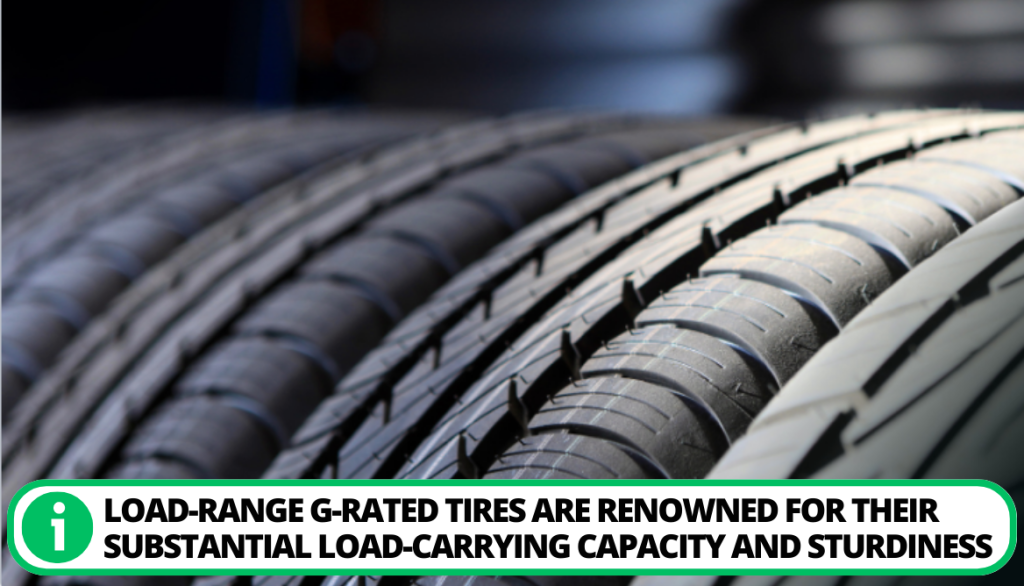
- Commercial trucks;
- Light trucks;
- Trailers.
The wheel tire size is 6.5 inches wide and 16 inches in diameter. With their robust construction and potential to withstand substantial weight, G-Rated tires are dependable for demanding applications.
The Privileges and Drawbacks of a G-Rated Tire
Choosing the proper rated tire that suits your vehicle’s needs might be challenging. G-rated tires are uncommon and not preferable for regular consumer vehicles since they are intended for specific heavy-duty functions.
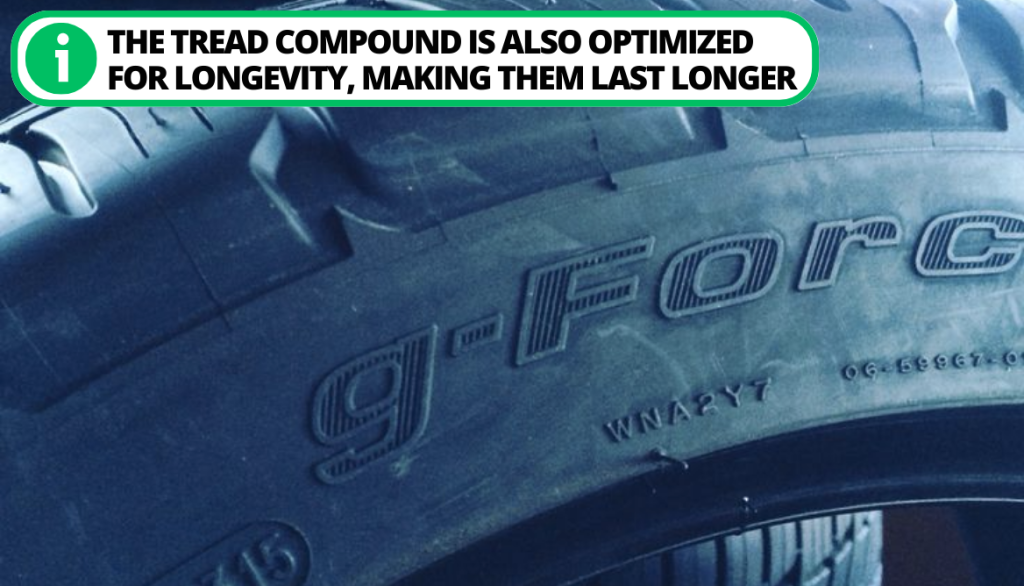
Let’s know some general information that presents the upsides and downsides of G-rated tires:
Here are several advantages of G-Rated tires:
- They are more rigid than lower load-rating tires, that’s why better to handle more weight.
- 14-ply tires are crafted with stiffer sidewalls that don‘t twist easily even under immersed pressure.
- The tread compound is also optimized for longevity, making them last longer.
- Its radial design provides a stable ride on highway use, especially when transporting heavy loads.
- Tires use less fuel than higher-speed-rated tires, thus saving money.
- They allow the driver to lower air pressure resulting in a smoother ride.
Let’s look at the drawbacks of G-Rated tires:
- They are restricted to a top-speed rating; they cannot exceed 56 mph. Above this speed, vehicle handling might be affected.
- Most RVs and trailers are designed for E-rated tires so you might need more room for G-rated options.
- Although G-rated tires can perform in all-season conditions, including dry handling, there is still room for improvement, especially on wet and snowy roads.
- Tires cannot be used for forceful and off-road conditions since they are crafted for long-term use and to perform heavy duties.
G-Rated Tire Ply: Understanding Ply and Its Importance
G-Rated tire composition comprises layers of materials to manage heavy-duty tasks and uphold significant loads, which includes the tire’s framework providing:
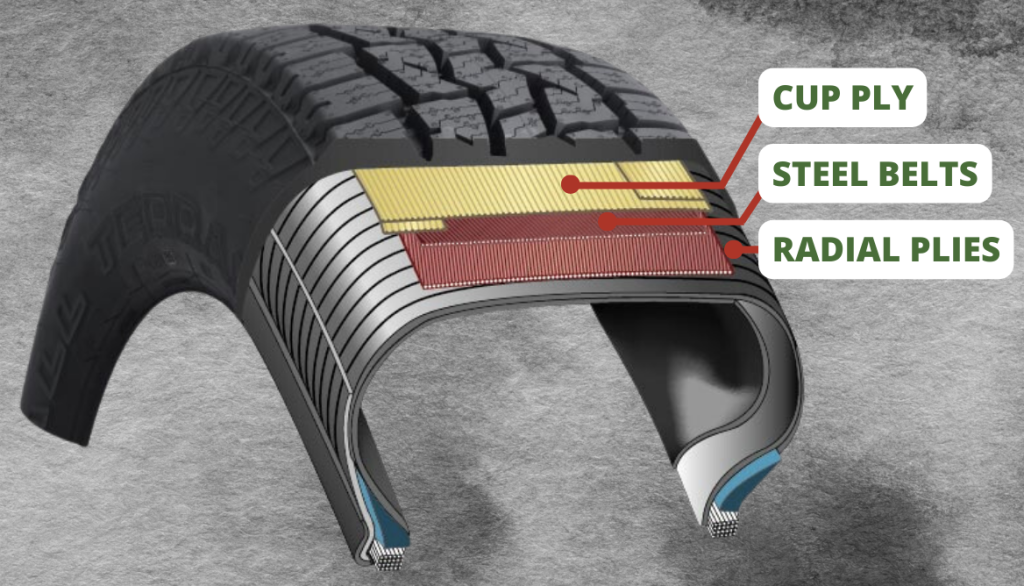
- Robustness;
- Steadiness;
- Resilience.
The “G-Rating” signifies the tire’s load-carrying capacity and suitability for managing heavy loads. Compromising the components of G-rated tires is essential to appreciate their performance and long-lasting nature.
Understanding G-Rated Ply
The G-rated tires are commonly crafted with 14-ply construction. Most people prefer load range ratings denoted by G instead of ply ratings. As a result, when searching for a G-rated tire for your trailer or light truck, choosing a 14-ply tire variant is recommended.

Let’s look at some important things about 14-ply:
- Load-carrying capacity: The composition of the ply directly influences the tire’s ability to bear heavy loads, making it appropriate for heavy-duty tasks.
- Strength: Multiple plies enhance the tire’s strength and resistance to punctures and impacts.
- Durability: Properly constructed plies contribute to better tire longevity and durability, reducing the risk of premature failures.
- Handling: Ply design ensures uniform weight distribution, improving overall handling and control of the vehicle.
- Safety: G-rated tire construction with appropriate ply materials provides safer driving experiences, especially when carrying heavy loads over long distances.
E-rated vs G-rated Tires: Understanding the Key Differences
Comprehending the distinction between E- and G-rated tires can empower consumers to make knowledgeable decisions based on their needs and vehicle requirements. Let’s examine some of their dissimilarities in detail:
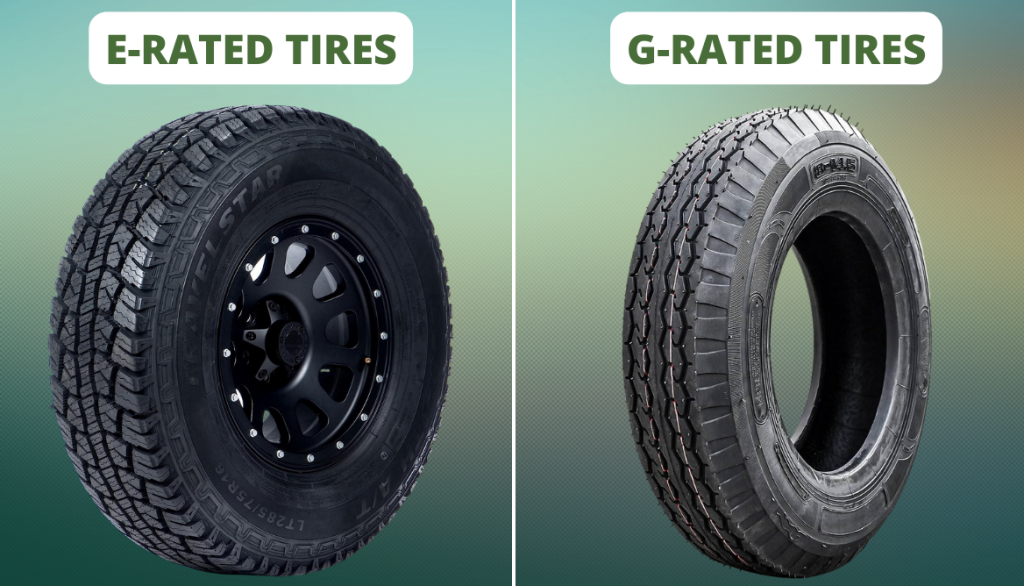
- Durability and stability: G rated tire is known to be stronger and more stable making it last longer than E-rated tires.
- Load ratings: In terms of how much weight each tire can handle, a G-rated tire carries more weight compared to E-rated tires. G-rated tires can handle a maximum load capacity of 4100 lbs, while E-rated tires can uphold a load capacity of 1520 lbs.
- Application: E-rated tires are generally designed for light trucks, on the other hand, G-rated tires are crafted for heavy-duty performance.
- Speed rating: G rated tire can manage speed up to 75 miles per hour while E rated tire cannot go beyond 65 miles per hour.
- Cost: G-rated tires are typically pricier than E-rated tires because of their specialized design and heavy-duty capabilities, making them better suited for commercial use than regular passenger vehicles.
Top G-Rated Trailer Tires: Finding the Best Option
Ultimately, G-rated trailer tire comes in diverse load and speed ratings. To provide your vehicle with the right tire, you must go through a thoughtful decision and do research. Let’s explore which is the optimum trailer tire below:
Hercules G-rated Trailer Tire
The Hercules G-rated Trailer Tire is widely acknowledged as one of the finest choices for G-rated trailer tires. Its G-rating signifies that it is specifically built to manage heavy loads, rendering it appropriate for various trailer uses.
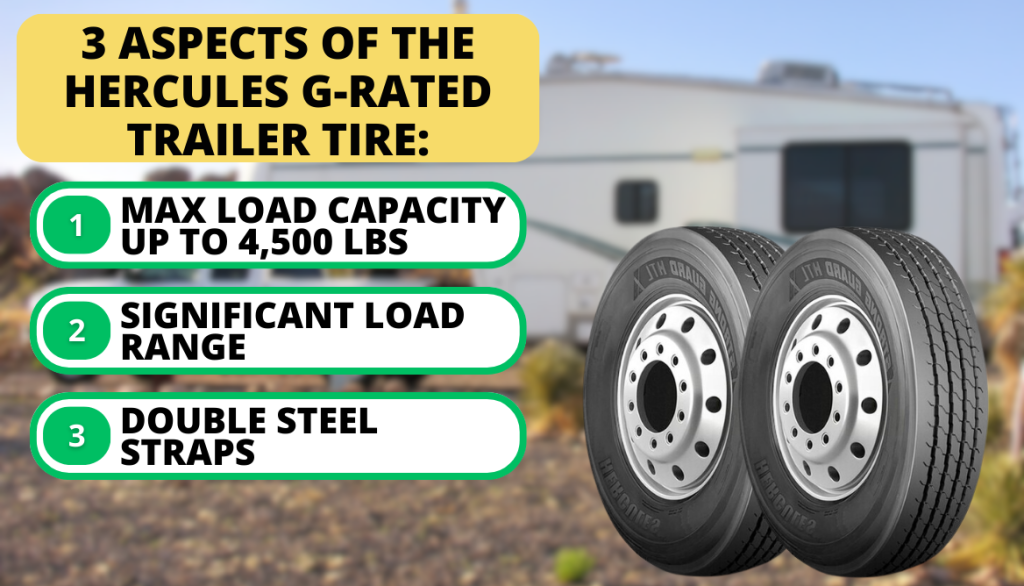
There are some aspects that make it the best option based on its maximum load capacity, load span, and load evaluations:
- Maximum Load Capacity: The utmost weight-bearing ability of Hercules G-rated trailer tires is contingent on the particular tire model and dimensions. Typically, G-rated trailer tires possess a total load capacity varying from approximately 3,640 lbs to 4,500 lbs.
- Load Range: Load range pertains to the tire’s ability to withstand diverse weight limits and tire-inflated pressure. It signifies that the tire is engineered to manage more substantial loads compared to lower-load range tires due to its 14-ply construction.
- Double steel belts: All sizes are engineered using high-tensile double steel belts, further reinforced with two nylon caps. This meticulous construction ensures exceptional durability and unwavering dependability, especially when dealing with the challenges of towing weighty loads.
G-rated Trailer Tires Made in America
Welcome to the world of G-rated trailer tires, where security, dependability, and efficiency are the top priorities. Regarding hitting the road with your trailer, having the right tires is essential for a comfortable, safe, and worry-free tour.
Let’s look at four popular brands of G-rated trailer tires, all proudly made in America. These brands have earned their reputation for manufacturing top-notch tires that cater to the needs of various trailers, ensuring you can travel with confidence and peace of mind:
- Goodyear: This tire manufacturer helps to provide endurance trailer tires specifically made for long-distance travel. The quality tread depth ensures that the tire is kept cool and the fabric-steel structure supports a higher load capacity.
- Michelin: Michelin is a reliable tire brand that is well-known for its great tire quality. They offer different types of G-rated trailer tires that can carry heavy loads and last long.
- BFGoodrich: BFGoodrich is a subsidiary of Michelin and is known for producing rugged and durable tires. The tires have high performance in extreme conditions. Their G-rated trailer tires are perfect for off-roading and can handle tough terrain. The tires have mud-phobic bars that increase traction by releasing compacted mud.
- Cooper Tire and Rubber Company: Cooper is an American tire manufacturer that produces high-quality trailer tires. The company often features sturdy construction on its tires to ensure easy handling of heavy loads.
Outcomes of G-Rated Tires as They Age
Let us look at some changes you’ll see when G-rated tires get old:
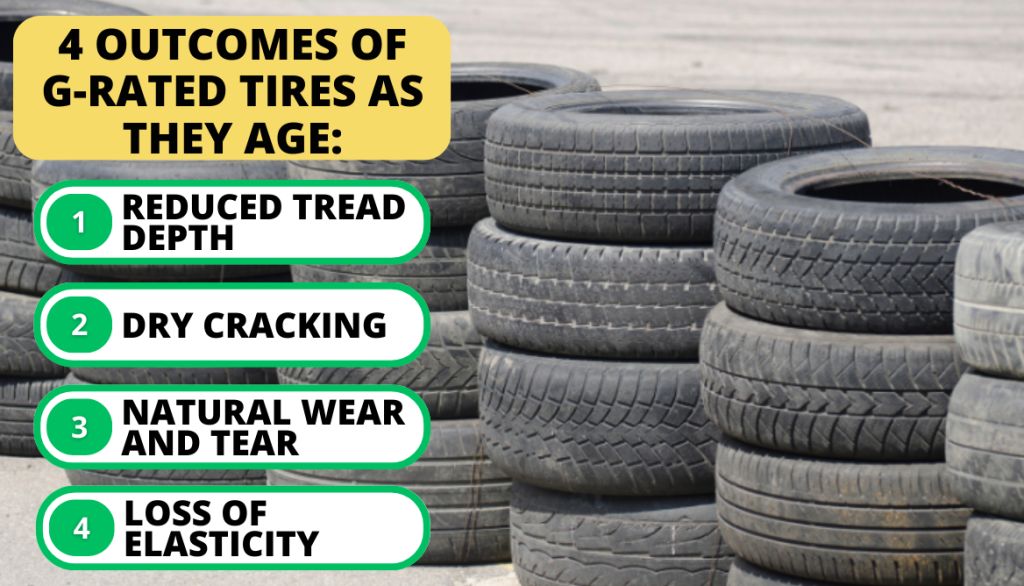
- Reduced tread depth: When G-rated tires get old, their tread depth reduces tire acceleration. This might cause the wheels to slip especially when driving on wet surfaces.
- Dry cracking: Long exposures to environmental factors like sunlight and high temperatures can cause dry cracking in G-rated tires. This affects their structure and appearance over time which increases the chances of having a puncture.
- Natural wear and tear: G-Rated tires, like all tires, experience natural wear and tear over time. This usually affects performance and safety. It also reduces the tire rating speed.
- Loss of Elasticity: Over time, the elasticity of G-rated tires may diminish, impacting their capacity to absorb road shocks and resulting in a less comfortable driving experience that could strain other vehicle components. Check your tire regularly to maintain optimal performance.
What Is the Speed Rating on G-Rated Tires?
Regarding speed ratings, G-rated tires typically have a maximum speed capability of 56 mph. Given that this speed is lower than the average speed on most highways, these tires aren’t highly rated among drivers.
Therefore, following the tire’s speed rating guidelines is essential to ensure safe and proper driving performance.
Tips to Tell If the Tire is New or Not
Below are tips to help you identify whether a tire is new or used.
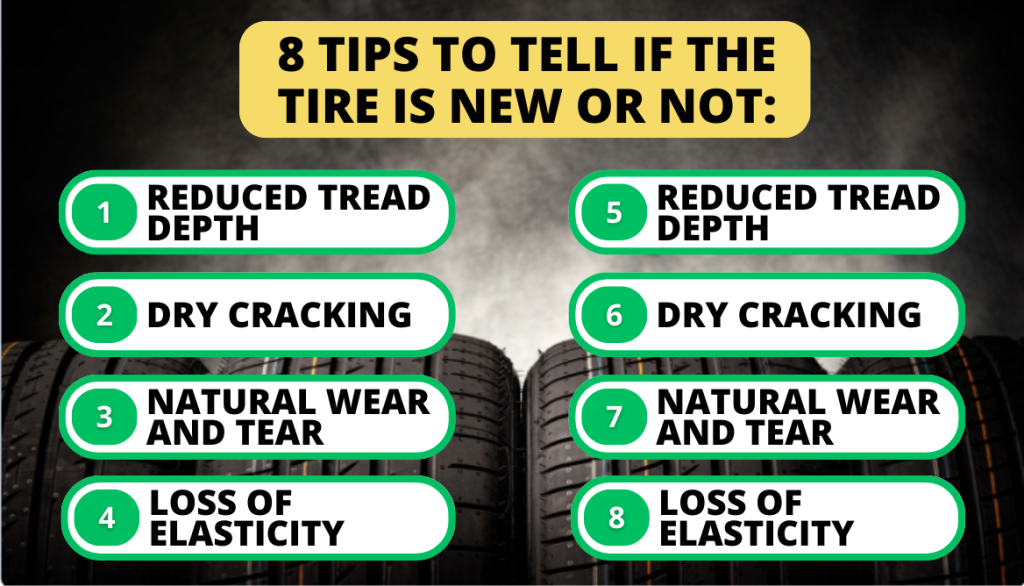
- Check the tread depth: New tires generally have deeper tread patterns, and the tread depth will be more uniform across the tire’s surface.
- Look for tread wear indicators: Most tires have small rubber bars running across the tread grooves. The tire is likely new or has minimal wear if these bars are still visible.
- Inspect the sidewalls: New tires should have clean, smooth sidewalls without cracks, cuts, or bulges.
- Check for manufacturing date: Most tire manufacturers display the Tire Identification Number (TIN) on the sidewall. Examine the last four digits of the TIN as they indicate the week and year of production. If the date is relatively current, it will likely be a brand-new tire.
- Examine the appearance: New tires typically have a glossy appearance, while older tires might look dull or faded.
- Look for stickers or markings: Some tires come with manufacturer stickers or labels indicating they are new or recently produced.
- Check for signs of usage: Scratches, scuff marks, or small stones stuck in the tread indicate a used tire.
- Verify the price: Brand-new tires are generally more expensive than used ones. If you find yourself doubting the price, it clearly shows that the tire is familiar.
FAQ
Is load range E or G better?
Load range E tires generally possess a greater weight-carrying capacity than load range G tires, making them better for heavy-duty trucks and towing purposes. Conversely, load range G tires might improve performance and longevity for extreme off-road conditions or sizable commercial vehicles.
What is the difference between F and G-rated tires?
F and G ratings refer to the fuel efficiency of tires in Europe’s tire labeling system. An F-rated tire has lower fuel efficiency compared to a G-rated tire. This means that a G-rated tire will consume less fuel and, in turn, produce lower CO2 emissions during driving.
What is ply rating G?
In the context of tires, “ply rating G” refers to the tire’s load-carrying capacity. The “G” rating indicates a specific load capacity level according to the tire’s construction and strength. Tires with a higher ply rating are designed to carry heavier loads and are typically used in applications that require increased weight-carrying capabilities.
How many load ratings do truck tires come with?
The load rating of each tire is inscribed on its sidewall, typically following the words “Max Load.” However, it is frequently supplied as a rating code; for light truck tires, it is approximately 2470 lbs (1120 kg), while for heavy-duty truck tires, it is about 7385 lbs.
What does G stand for on tires?
The “G” on tires denotes the tire’s speed rating, indicating the maximum speed a vehicle can travel at for a sustained amount of time without compromising safety.
What speed rating is G?
The speed rating “G” typically corresponds with 56 to 62 mph (90 to 100 km/h).
Conclusion
G-rated tires stand out as a reliable and safe choice for drivers seeking superior performance and durability on the road. With top-tire construction and adherence to strict industry standards, G-rated tires are engineered to manage heavy loads and high velocities.
They are a worthy investment for any vehicle to ensure a smooth and comfortable ride. So, they are undoubtedly the best option for dependable, high-quality tires.
Have you ever tried using G-rated tires before? Share your experience in the comments section below.

I`m a current Law Enforcement Officer working within the Counterterrorism Bureau in New York State. I have been Camping for over 20 years. My styles of camping include tent, car, truck, van, and RV travel trailer. I have a YouTube channel where I teach all types of camping with an entertaining method: https://youtube.com/@TheSmallsRVAdventures






